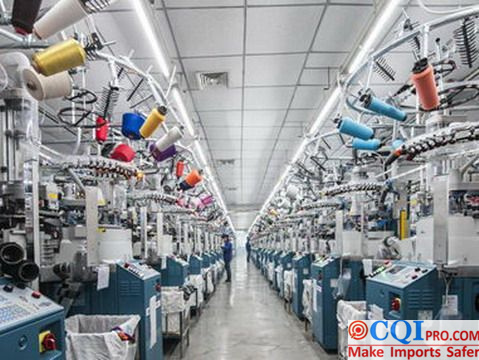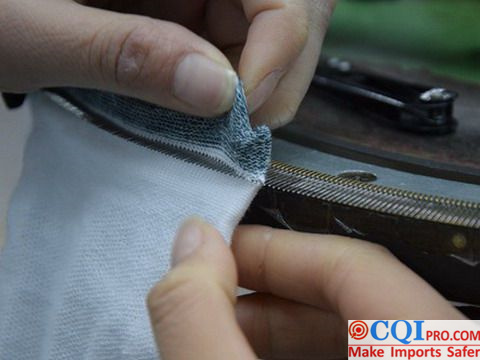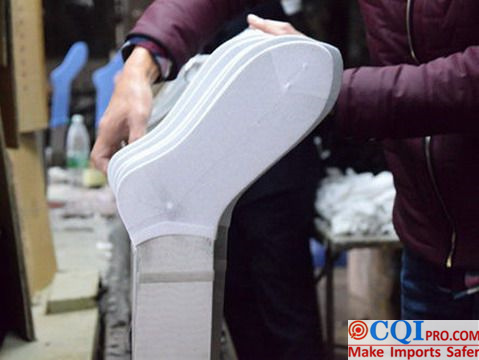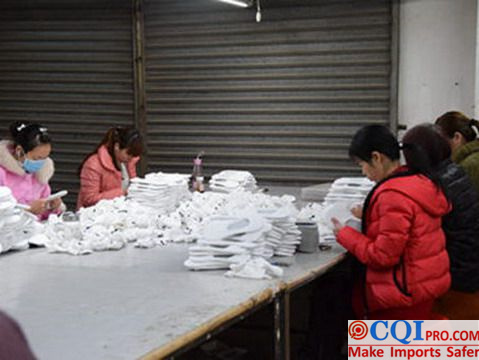Socks Quality Inspection Found Potential Defects In The Process.
According to the ” China Socks Industry Market Prospects and opportunity study Report 2018 – 2023″ released by China Merchants Industry Research Institute, China exported 1533 million pairs of socks in June 2018, up 9.8 percentage points year on year. From January to June, China exported 7461 million pairs of socks, up 6.6 % year on year.
Socks Quality Inspection’s Centralized Supply Chain Area
At present, there are 3 domestic sock production bases:
1.Zhuji Datang Town, Zhejiang Province
Datang Light Textile Hosiery City, with a construction area of 120,000 square meters and 1,600 merchants, is currently the largest domestic hosiery trade complex integrating light textile raw materials, hosiery products market, hosiery machine accessories market, joint shipping market and exhibition, tourism and shopping, with an annual achievement of 8.5 billion yuan.
2.Liaoyuan, Jilin Province
Liaoyuan has been producing socks for more than 70 years since 1937. The head of Northeast Hosiery Textile Industrial Park said that by the end of 2017, there were 1,210 enterprises in the park. The output of cotton socks in the park accounted for 1/4 of the national market share, with an estimated annual output of 3.2 billion pairs.
3.Lishui Town, Guangdong
From the pilot towns of small town comprehensive reforms in the country in the mid-1990s and the pilot towns of small town construction, the“China Socks Famous Town”.

Socks Quality Inspection And Manufacturing Technology
What kind of manufacturing process would such a small pair of socks need? CQI Inspection Company has taken you through years of inspection experience to understand the overall manufacturing process of socks:
The first step: material selection and good material can produce good socks.
With the progress of science and technology and the improvement of living standards, the materials of socks are also increasing, such as natural fibers ( cotton, linen, wool, silk ) and regenerated fiber ( Tencel, modal, bamboo fiber, soybean fiber, pearl fiber, milk fiber, etc. ). People pay more and more attention to comfort and health than just wearing clothes.
Socks are mainly composed of three aspects:
Main materials: All kinds of fibers ( natural, synthetic and regenerated ) make up the basic structure of socks.
Secondary material: elastic fiber, which shrinks the sock close to the foot surface and prevents the sock from slipping.
Auxiliary material: rubber band, which can shrink the hosiery to prevent the hosiery from collapsing and falling. Jacquard thread, making all kinds of exquisite patterns, mainly high elastic, nylon and cotton yarn.
For example: Like building a house, the main material is the frame of the house, the secondary material is the wall of the house, and the auxiliary material is the decoration of the house.

The second step: Weaving. After selecting the right materials, we will reach the weaving link.
Socks have just been produced in a cylindrical, circular structure, with a continuous winding of a thread to form a long cylindrical shape. One end is the socks mouth ( with rubber band ) and the other end is the socks head ( finished product is sewn and worn on the toe ). Workers turn it from the front side to the back side of the hosiery to carry out the next sewing step.
To produce good socks , you can’t do it with good machinery alone, must have the same excellent operators. A good hosiery machine operator can only be called a good operator after 3 months of skill training , then through 1-2 years of continuous familiarity and experience. Excellent operators can not only save energy and reduce consumption for the company, but also adjust the process and check the product quality in time in daily operation to avoid unqualified products flowing to the next link.
Therefore, this step directly affects the quality of finished socks. If the operation is not proper, the socks will easily have needle holes, or the uneven yarn will cause a BARRE. Don’t think that a third-party inspector will be easy in inspection of such a small product on the field, In fact, during socks quality inspection, they need to scan every pair of socks.

The third step: sewing, after the cylindrical blank socks are transferred to the sewing link, they can be divided into manual sewing and machine sewing according to the product sewing requirements.
Hand – to – eye suture, also known as boneless suture, is to sew a needle in the toe of a sock through a disc-mounted needle tray by hand, requiring a needle eye and a needle without dislocation.
Advantages: No joint at toe, smooth and comfortable to wear.
Disadvantages: Low production capacity, slightly higher cost and long time for large-scale production.
Machine stitching is to transport the parts of the sock head that need to be stitched to the entrance of the machine by means of manual transportation, and directly stitch by the machine.
Advantages: fast sewing speed, suitable for large-scale production and can also be completed in a short time.
Disadvantages: Can’t achieve the effect of pure hand stitching, toe part has a connector, no hand stitching smooth, wearing is likely to cough up feet.

The forth step: Socks quality inspection. As the name implies,socks quality inspection is to check whether the socks are qualified.
It is reasonable to choose professional and comprehensive inspection after sewing. Because after the sewing step, there will be very few defective products visible in detail in the subsequent step, which can be inspected in the packaging step. However, knitting and sewing links are prone to unqualified products. Therefore, by setting up socks quality inspection links after sewing links, the product qualification rate can be improved and the waste of production capacity in subsequent links can also be reduced.
Most of the tests are in the form of a set of plates, 360 degrees to check the surface defects on the sock surface and check whether the size of the sock is up to standard. Nonconforming products found during Socks quality inspection, directly enter the waste warehouse, and the conforming products are transferred to the shaping link.
The fifth step: finalize the design
The shaping link is to cover the sewn socks on various specifications of the metal sock board, and the high temperature and high pressure generated by the high temperature of boiler steam will cause the internal elastic fibers to contract and smooth the fluffy shape or folds of the sock surface. And then drying and cooling to achieve the goal of shaping the sock surface. Generally, socks are ironed at 2 atmospheres. Most textiles need ironing technology in the end, you can click Ironing this article.
The sixth step: Packaging
People rely on clothing, Buddha on gold. Of course, good products should have good packaging. According to requirement of socks quality inspection, the surface of each sock need to be inspected again through the matching process and matched with two socks of the same length; Then according to the product requirements, match the cooperative and beautiful trademark, and then pack the bags and boxes according to the requirements, so a good sock is finished.
However, the third party inspection company appointed by the purchaser to perform socks quality inspection, needs to carry out the final sampling inspection and evaluation on the appearance, size and packaging of the socks. There are some small factories that do not strictly control this part of knitting and sewing, and it is easy to have defects such as yarn breakage, flower-shaped deformation, needle leakage at the sewing head, knitting holes and different lengths.
In addition, we also have an article on the technology of knitwear. If you are also interested in knitwear, please refer to this article knitwear inspection.
CQI5 is committed to providing importers worldwide with product quality inspection services that far exceed those of our peers. If you are planning to import or have imported from China or Southeast Asian countries, please contact us cs’@’cqipro.com to learn more about how we can make your imports safer.
This article is an original article for CQI Inspection, who is committed to providing high-quality product inspection technology and know-how sharing for global importers and retailers to make imports safer.
All rights reserved. The contents of this website provided by CQI Inspection may not be reproduced or used without express permission.
For reprint, please contact with CQI Inspection, thank you.





